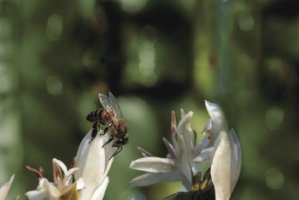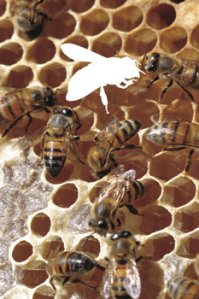
eduardo cesarTime to leave the nest: in response to vitellogenin, the worker specializes itself in field work and sets off in search of food for the beehiveeduardo cesar
“The life of bees is like a magic well. The more you take away, the more there is to take away.” The phrase comes from Karl von Frisch (1886-1982), the Austrian who deciphered the communication between bees and for this work divided the Nobel Prize for Physiology and Medicine in 1973 with two colleagues, and earned the title of the Father of Ethnology, the study of animal behavior. The biologists Zilá Simões, Klaus Hartfelder and Márcia Bitondi, from the Bee Development Biology Laboratory (LBDA) at the Ribeirão Preto campus of the University of São Paulo (USP), have for more than two decades been taking precious items from this well. They are investigating how genes and hormones interact with the environment and determine the casts of bees, one of the great mysteries of biology. The Brazilian team makes up part of an international consortium of research groups that during October announced the sequencing of the bee’s genome, the first social insect to be studied in this manner. What came within this bucket, drawn up from the well, shows that Von Frisch’s declaration is more up-to-date than ever.
In a society of bees only the queen bee reproduces. The workers look after the larvae and guarantee the maintenance of the colony. Charles Darwin was frightened that the existence of a sterile could put his theory of natural selection at risk, which states that only those who leave fertile descendants will win the game. This enigma has been studied from various angles during the last century, and now genomics is going to give a helping hand. As participants in the Genome Project, the researchers from Ribeirão Preto are responsible for investigating the genetics of the formation of casts. Based on experiments done over the last decade, they are now annotating 51 genes, decisive in differentiating queens and workers and are unveiling a complex system of genetic regulation key in the evolution of the bees’ social system.
Shortly after birth
Anyone who believes in the supremacy of the genes may be surprised to discover that bees of different casts are equal from the genetic point of view. “This has already been known for decades”, says Zilá. During the first 48 hours of life, explains Márcia, it is enough to feed any larva with royal jelly and it will give origin to a queen bee. The beekeepers who raise bees for the commercial production of honey and propolis, use this knowledge to multiply their beehives.
In spite of the genetic homogeneity, the differences between the casts are marked. A queen lives between one and two years. During this time she puts out up to 2,000 eggs per day, starting from her spermatozoid, stored after a single union. The workers seem to be, to a certain extent, dispensable. They live between 30 days and six months, and on becoming field workers have an immunological system that is little active and they eat less, practically only carbohydrates. Dozens of thousands live in each colony and, on dying, they are substituted by others.
During its life of toil, essential for the survival and the growth of the beehive, the function of the adult workers varies according to their age: to clean and build the beehive, to feed and look after the larvae under development, to defend the colony and to collect food. During this last position they are called field bees. In order to monitor the behavior of these insects during these stages, the researchers at the Bee Laboratory observed glass cased beehives, where the worker bees are marked with numbered and colored platelets stuck to their backs. The dressed up bees did nor seem to be uncomfortable: they continued to fly and, on returning to the colony, to dance to indicate to their companions where the food is.
To explain the orchestration of all of this varied and physiology behavior has, for more than two decades, caught the curiosity of Zilá, Hartfelder and Márcia. In order to understand how a queen or a worker is made, they conceived of an extensive investigation of the genetic and hormonal working of the bees. Their effort has born fruit: before they had initiated the Genome Project, the group had already identified and sequenced a gene central to the differentiation of the casts. It is responsible for the synthesis of vitellogenin (VG), a protein essential for reproduction, since it represents a good part of the food that nurtures the embryo within the eggs. As well as its reproductive function the vitellogenin influences longevity and in the insect’s immunological system, both for the queens and the workers.
The research project carried out at the LBDA indicated that the feeding of the larvae with royal jelly has a direct influence upon its hormonal system, which increases the synthesis of the juvenile hormone. These larvae then turn themselves into queens, which produce more vitellogenin. “It’s possible to produce queens without royal jelly”, says Zilá. “The juvenile hormone experimentally applied already leads to its formation.” According to researcher Hartfelder, an accentuated cellular death is programmed in the ovary cells of the workers. More juvenile hormone in the queen larvae impedes the degeneration of the reproductive organs. The workers, which escaped from the massive dose of juvenile hormone during the embryonic development, are not free of its influence. At a certain point in their lives the production of the hormone increases, the synthesis of vitelogenin drops and they begin to fly in search of food: they become field bees.
Beware: It is not the case to call the VG gene as the “cast gene”. The genetic interactions are very complex and are still far from being fully understood. With the genome sequencing completed, now it will be possible to investigate, in a more general manner, the influence of the genes on the organism and in the behavior of bees. In the case of the LBDA, the team has identified in the genome 51 genes linked to cast development. The researchers believe that these are not the only genes involved in the process, but they appear to be among the most important.

eduardo cesarDestiny after coming out of the egg: the dose of juvenile hormone defines if the larvae will be queens or workers like theseeduardo cesar
Accelerated work
The geneticists believe that the results concerning the genome will bring about major progress in knowledge about these social insects. To work with one gene at a time is very slow. Zilá estimates that it could take a year to sequence each one of them. To this end, the method ten times faster used in the genome sequencing projects allows for an incomparable advance. But is the laborious experience of researchers Zilá, Márcia and Hartfelder with the genetic and hormonal systems of the bees that has led them to integrate into the international consortium that brings together 170 researchers from 65 institutions to decipher the bee’s DNA. The estimation is that its genome will be composed of around 10,000 genes, less than the other insects already sequenced: the fruit fly (Drosophila melanogaster), the mosquito that transmits malaria (Anopheles gambiae) and the silkworm (Bombyx mori).
With the sequencing of the genome, facts spring up that previously could not have been studied. In this case questions typical of social insects, such as the division of labor, the reproductive casts or the communication systems. A simplified process, which has already been used in other projects such as that of the bovine and eucalyptus projects, allows for the sequencing of only the active genes, those that lead to the production of proteins.
However, the DNA contains an immense number of other strips that do not directly produce substances and for this reason they are called the non-coding region. However, more and more research is showing that these regions of the genome are of immense importance. “The complete genome brings information about regulating sequences”, explains Hartfelder. The regulation system allows for an understanding of how the organism works, and could be the origin of marked differences between animals genetically similar. The analysis of the bee’s genome has already brought important clues about the mechanisms of regulation of the genes – the methylation system and the microRNAs. These are molecules capable of switching off the genes and for this reason they determine the parts of the active genome according to the individual and the moment. The interactions within the genome and the activity of the genes are known as genic networks. This type of system can be responsible for a good deal of the differences between the reproductive and non-reproductive cast, as well as determining the successive functions of the worker bees throughout their lifetime.
The difference between queens and workers, for example, becomes evident when one studies the genic networks of the two casts. These networks are represented as small circles that indicate the super expressive genes (more active), with lines between them that show functional links – an active gene or another inactive, for example. Zilá showed two of these schemes, one of them so intricate that the links jumble together in front of the eyes: “This is a worker”, she points out. The simpler shows that of a queen. For the geneticist it is like looking at photographs of the bees of the two casts. The operators have a larger brain, with more neurons, and its genic network is more complex.
As well as representing an important advance in the understanding of a social insect, the Bee Genome Project may practical applications. Zilá highlights the possibility of genetic improvement of bees for the commercial production of honey, since now it is known which of the genes confer desirable characteristics. But the research in apiculture Mendelson Guerreiro de Lima, from the State University of Mato Grosso (Unemat), views the advance with caution: “New research results take time to be applied in the field”.
Brazil is one of the largest world producers, since it was here that the hybrid bee was bred, a variety between the European and African bees, much more productive and resistant, but also extremely aggressive – or defensive as Hartfelder would say. But, explains Lima, because of the extractive nature of Brazilian apiculture, the production per beehive is around five times less that in Canada, for example, where the climatic conditions limit the production time to half of the year and make the beekeepers to optimize their productivity.
From her window of the USP campus at Ribeirão Preto, Zilá and her colleagues can observe the beehives where the bees that they study live together with agoutis, tegus and boa constrictors. This scenario, so Brazilian, already makes up part of the international landscape, as proof of the presence of Klaus Hartfelder: he took his doctorate degree in Germany in collaboration with a Brazilian group and ended up exchanging an academic career in his native country for one at USP in the interior in the interior of São Paulo. Zilá says that the Bee Genome Project also has this merit: it has led the international community of researchers into social insects to interact in a much more active manner. With this embroiled team, the magic well will not be calming down.
The Projects
1. The functional genome of the Apis mellifera – search for new genes and functional networks in the context of the development, cast differentiation and reproduction (nº 05/03926-5); Modality Thematic Project; Coordinator Zilá Luz Paulino Simões – USP; Investment R$ 830,083.39 (FAPESP)
2. Modeling with differentiated equations on the sexual development of the Apis mellifera; Coordinator Zilá Luz Paulino Simões – USP; Investment
R$ 99,000.00 (CNPq)

